Can the Circle Be Unbroken [1]: Susan Howe’s Ghostly Grand Collage
“Secret Paintings / the / object of which is not / to be seen // He made a secret out / of what no one / wanted anyway” —Paul Thek, from his journals, quoted by Susan Howe in Debths [2]
In 1650, Welsh metaphysical poet Henry Vaughan published Silex Scintillans (trans. The Fiery Flint) in the wake of a prolonged and likely painful illness. Almost midway through Silex is “The Evening-Watch”, a poem of dialogue between Body and Soul. At the end of the conversation, Soul bids Body sleep. The poem opens out to a lullaby departure from angle and frame, an attempt to describe eternity through dialogue that dilates to imperative, soul still chattering to body even as temporal blinds limit vision:
Ah! go; th’art weak, and sleepy. Heav’n
Is a plain watch, and without figures winds
All ages up; who drew this Circle even
He fills it; Dayes and hours are Blinds.
Yet, this take with thee; The last gasp of time
Is thy first breath, and man’s eternall Prime. [3]
Here is an image of one of the last paintings from artist Paul Thek, from his series Diver, completed in 1988, 330 years after the publication of Silex Scintillans.
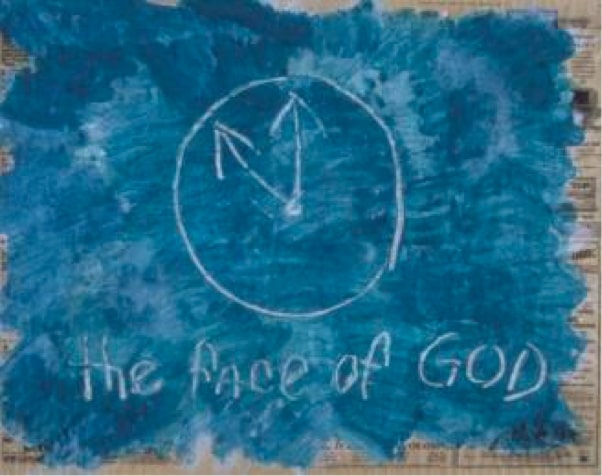
Paul Thek, “The Face of God”, 1988, Synthetic polymer and gesso on newspaper, 21x7 inches
The poet Susan Howe invokes Thek’s piece in her 2017 book Debths —“Here are messages. ‘The Face of God.’”—in a cryptic reference to a painting the object of which is already “not / to be seen.” [4] Many of Thek’s final works are characterized by thinly applied layers of gesso and vivid blue acrylics painted over delicate newspaper, obscuring the text of the newspaper except for the edges. Diagrammatic archetypes, lone figures, and short phrases are then painted over the blue. In “The Face of God” Thek has painted a simple circle left slightly broken, a clock without numerals, with hands wound, or winding, upward. It is a visual correlative to Vaughan’s assertion in “The Evening-Watch” that “Heav’n / is a plain watch, and without figures winds all ages up.” Both Vaughan and Thek implement the diagrammatic as a way of getting at an intangible spirit world. Thek renders his “face” of God and the words beneath it in unruly, childlike strokes. He mostly worked with small ocean paintings on fragile substrate here in 1988, the same year he died of AIDS. In his last exhibition, he hung this painting with others at child’s eye level.
*
Near the end of Debths, Susan Howe imports a phrase from Henry Vaughan’s “The Evening-Watch” into a section of her series “Periscope,” named after one of Paul Thek’s late “picture-light” paintings from Diver:
These quiet stars each free
intelligence sealed from us
Days and hours are blinds
These screens these means
each new extreme outvies
each quickening after after
I am interested in how allusively rogue Howe goes in recycling Vaughan’s line–“Days and hours are blinds”—without any form of citation. The usual indicators—quotation marks, footnotes, italicizing, blocking off—would slow the audio and visual charges of the poem. Instead, Howe stays true to the formal speed of an echo received and transmitted in slight disjunction from the duplicated moment of contact with Vaughan’s original line. Haste, spark, and partial electrical transference across centuries are incorporated in the poem through the active-receptive impulse of the medium-poet, from one source to another.
This citationless, stylized transmission of particulates from the “source” (in this case, Vaughan) is formalized by Howe’s use of collage-making techniques—the processes of cutting, fastening, and overlapping—to create zones of association and indeterminacy where neither sight nor sound can outvie the other. These techniques inform every aspect of her work, from her essays to her more “traditional” lyric poems such as “Periscope”, to her actual work in collage. In the above section from “Periscope” she collages a scrap from the metaphysical tradition—not in service of the quest towards heightened revelation one might expect from Vaughan—but in acknowledgement of the slipperiness and opacity of written language from the past as it is fastened into a moment of re-composition towards “each quickening after after”. Howe overlaps exterior language with her own language in a process that depends not only on the past, but, as Paul Celan writes in one of his posthumous critical fragments,“[t]he anticipated: the bringing over of the future too into the poem’s only time: the present.” [5]
Howe is known for troubling the line between collage-making and poetry. She has been dismembering source-texts with scissors and presenting it as a hybrid form since at least the late 1960s. [6] In the beginning she would hang these scraps of language on her walls, but after the death of her second husband in 2008, she began incorporating collage into her later books: scanning source-texts, cutting them up, fastening remainder language with Scotch-tape, and reproducing the collage with another scan. So the rendering is already duplicitous at least. An alternative, even pre-articulate, form of poetic knowledge is suggested by Howe’s techniques of collage, primarily via the mediumistic-haptic processes of cutting and fastening.
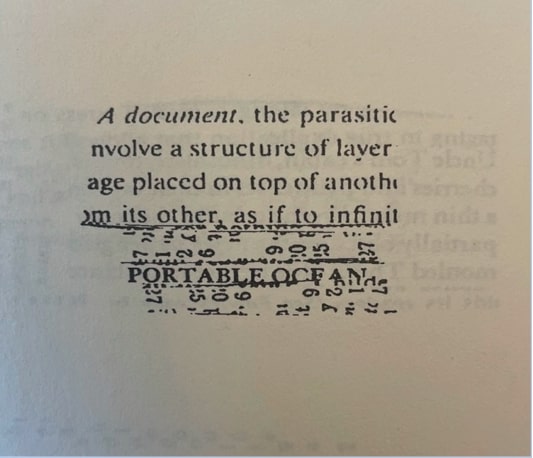
a collage from Debths, 66
Cutting and fastening are achieved with the help of the hand. The hinge of bone between index and thumb is the primary zone where the prehensile impulse is enacted. Scissors are designed with this hinge in mind. Howe’s hand transforms relations to the past with a pair of trickster’s scissors and some tape. To cut an old hymn down to the phoneme. Taped to the page so the song is seen, “For now, in haste,” as through transparent “ceiling silhouettes.” [7] So that its immanent transformation, its ruin, can be made visional.
In her latest book, Concordance, Howe posits the cut as a technique that disrupts standards of narrative and linear time: “[t]rusting that as a helpful reader you will respond in your rabbit self. I have composed a careful and on one level truly meant narrative and on the other level the Narrative of the scissor.” [8]
A rabbit is nimble and easily frights. Their ears are prone to give them up. A hop moves in rhythmic dischord with a step and allows more angles. Although for Howe each cut works against intentional narrative structures, there are spatial constraints to the use of scissors that keep things together. The cut in collage is a formally determined line of severance that re-angles an already angularly arranged host-scrap. The cut visually resembles poetry’s optics of enjambment and line, but permits more slant. Hybridizing these styles of visual marker re-angles the sight/sound experience of reading so that the fragments displayed are at cross-purposes with linear configuration. In simply looking at Howe’s collage poems, the formal dimension of the poetic page is both maintained and revolted against. This multiplication of angles, which also increases the number of enfolded voices, is technique for the delirium by which “a thought might hear itself see.” [9]
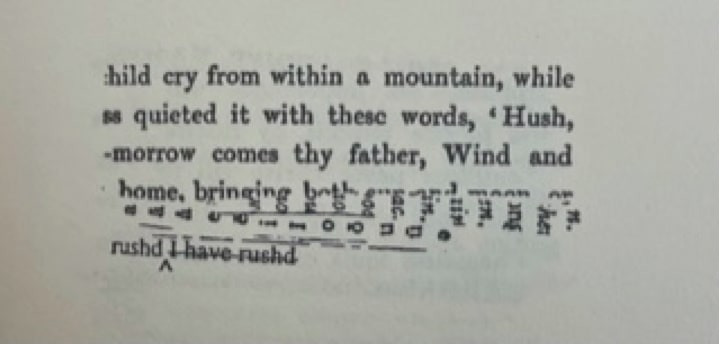
a collage from Debths, 59
Collage as a form presumes a kind of initial thievery. Despite the dismemberment and disappearance created by the cut, something of the host-text remains, which Howe fastens into her poems: every cut necessitates a fastening. The act of fastening itself posits indeterminate relations between sources. It creates a conceptual hinge (overlap) that produces motion to and from concealment and exposure. It can be considered an intimate communal action or reception created by what mutated version of the host-text the cut leaves behind. A mode of relation, however oblique, occurs when a collage artist selects and arranges from a heap of fragments severed from intentional cohesion. Fastening is indexical without being subject to scholarly rules, or, as Howe puts it in Concordance,
“Google again for the source of my quotation and I’ll fetch you another governess-related origin in grandmother glossolalia, kinesthetic shadowy defining other metaphoric surface-embroideries folding and fracturing retracing convoluted needlework patterns.” [10]
The remainders of exterior language that Howe fastens onto her poems are revived in their fiddled-with duplications, however folded, fractured, un-traced, re-traced, creased. The sheer pervasiveness of fastened voices in her work subverts the notion of lyric originality, particularly in the poet’s permeable relationship with the dead. Howe helps put to rest the notion of the isolated “voice” by insisting on polytextual collage to the extent that it becomes difficult to discern where her seeing voice begins or ends.
*
In his 1967 book Bending the Bow, the poet Robert Duncan, a longtime inspiration of Howe’s, proposes the existence of “a poetry of all poetries” created by a “we” that he defines as no less than all that is alive:
“I’d like to leave somewhere in this book the statement that the real ‘we’ is the company of the living, of all the forms Life Itself, the primal wave of it, writing itself out in evolution, proposes. Needs, as our poetry does, all the variety of what poets have projected poetry to be.” [11]
Of all the art-forms Duncan could use to define such an ever-fluctuating, grand poetic “we”, he settles on collage:
“In the poem this very lighted room is dark, and the dark alight with love’s intentions. It is striving to come into existence in these things, or, all striving to come into existence is It—in this realm of men’s languages a poetry of all poetries, grand collage, I name it…In this room we, aware or unaware, are the event of ourselves in It.” [12]
For Duncan, the multitudinous, inclusive process of collage is a suitable correlative for a cosmic “It” that nonetheless eludes classification. Others have pointed out the essential paradox of this formulation. In his 1979 essay on Duncan, the poet Nathaniel Mackey draws out the troubling, irresolvable aspects inherent to Duncan’s “commune of poetry”, understanding this room of grand collage as one in which failure and darkness preclude and perhaps even eclipse the congregational light that Duncan proposes: “Its inability to encompass or incorporate that Whole takes the form of a certain ‘darkness’ conducive to—a muse of motivation for—the postulation (if not hallucination) of ‘light’”. [13] Mackey goes on to point out the necessarily reductive qualities of Duncan’s Utopian notion of a universal poetry made manifest: “This impalpable All reduces any empirical achievement, makes it incomplete, each ‘completed’ poem merely further evidence of the ongoingness, the inexhaustibility, of Creation.” [14]
Howe’s work enacts something of Duncan’s grand collage and also something of Mackey’s suspicion of its attainability. While Duncan defines the “we” who collages as “the company of the living”, Howe exclusively collages the voices of the dead. In keeping their company, she subverts the aspirational with the apparitional. The composite particulars of her collaged voices may strive for the gnostic “it” that Duncan speaks of, but, for Howe, it is left outside the darkroom of the poem, where no form or knowledge lies:
If to sense you are
alive is pleasant itself
or can be nearly so—
If I knew what it is
I’d show it—but no
What I lack is myself
To submerge one’s voice in others. Self could go beneath the waves of sounds of outer source-transmissions split across this looking through the many tilted mirrors of a periscope. The aperture is multiplied so it becomes trickier to trace back an eye. A glaring duplicity in poetry is its ability to allow the speaker vocal presence beyond the bounds of self in time. By the end of Debths, Howe’s lyric self becomes a negative, whose light, if seen, is seen inversely through the channeling of the dead at a malleable remove. As Mackey reminds us in his essay on Duncan, “No matter how nonchalantly stated, the fact is that life enigmatically turns upon an absence.” [15] In “Periscope”, the shadowy overlap of blinds and screens takes precedence, the voices of the dead cut from their be(ing) “at the lief end of ciphers.” [16] I without self, it without knowledge, lief without be—“Sweet blue water, what could it be?” [17]
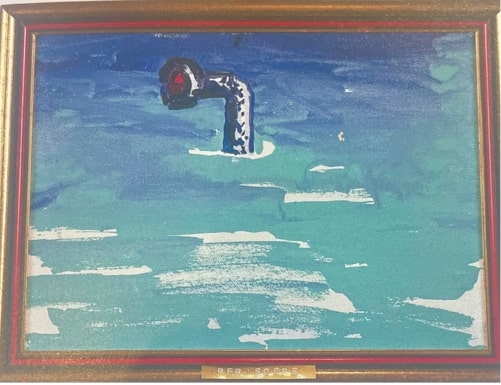
Paul Thek, Periscope, 1979-1980 acrylic on canvasboard with artist’s frame and
picture light 12 x 16 in [18]
If Howe’s work can be said to strive towards something of the “Wholeness” of the grand collage, it does so on terms that maintain faith in even the barest of optic and acoustic notations. One half severed vowel can induce involuntary memory and an intimation of a larger pattern. A fracture is a true fact rearranged. Fasten this to the edge so vulnerability and hiddenness can exist at once, the old character revived but not according to the bounds of individual authorship. As for the question of permission to loose these bounds, Howe has always revolted against patriarchal strictures of grammar and literary inheritance.
This being said, Howe’s collaging of other voices runs the risk of exploitation. For instance, Howe’s forward to Debths makes no mention of Paul Thek’s queerness or of the violent homophobic conditions in which he completed his final works, and because of which he died at 54. Although this remains a tangible erasure, Howe’s introductory prose more often works to imagine and factualize the lives of the people behind the “miniature network entanglements” that can be found in her poems. [19] In the forwards to her collections, Howe constellates her debts to the depths of the voices she folds in her poetry without giving away her specific linguistic borrowings. [20] In this sense, she provides enough historical scaffolding to allow her readers to discover the source of her fastenings on their own terms. The tonal reverence and factual patternings in her prose often operate as invitations to trace the connections beneath her more elusively polyvocal poems. Death, too, grants Howe the space for telepathic citationless fastening of other voices. In her early essay “The End of Art'', Howe quotes Henry Vaughan, but this time she cites him by name: “‘Death is a Crosse, to which many waies leade, some direct, and others winding, but all meet in one center. — Henry Vaughan’” [21]
Howe’s collaging of the dead might emerge from an intuition of this “one center” crossroads dissolving the limits of singularities. Papery voices in remainder could help notate on flux a zone she seeks where “music before counting comes from.” [22] Decreation’s scissors fracture pathways to a hastened grace. Host-scraps are leveled at the act of scavenge.
*
“Afraid to unfurl. Too green to burn. Make a list of your secret fears.”
–Paul Thek, from his journals [23]
Although I could never participate in one of Paul Thek’s installations, permission to associate is transmittable. Thek became well-known for his 1967 exhibition The Tomb at the Whitney Museum of American Art, where he constructed a faux pink pyramid and a beeswax effigy of his corpse dressed up in a pink suit for viewing. In the chamber of the pyramid he surrounded his hushed double with a funerary bowl, private letters, and pink goblets. Thek wove his beeswax body’s hair with delicate jewelry: “I was making jewelry from hair and gold, which was too fragile to ever be worn, but it was really beautiful, so I thought there must be something to put it on.” [24] The grandiosity and melodrama of his installation resisted the cold and fashionable minimalism of the 1960s. Ceremony concretizes abstraction. Bold, bodily, and interactive, The Tomb prefigures his later, more elaborate installation experiments with sacred architecture, found objects, process art (Processions, he called them), liturgy, and memory.
Twelve years after its appearance, when a museum in Germany requested a redux of The Tomb, Thek expressed exhaustion and dread at the prospect to his friend in a letter: “I really don’t want to have to do THAT piece again! Oh God no! Not THAT one. Imagine having to bury yourself over and over.” [25]
Thek refused to drink from standing waters. Susan Howe collages his complaint without citation into one of the most memorable sections of Periscope:
Hut running on chicken legs
Achilles has his heel what’s
left to a thirdhand sightseer
Caves and rivers imagine
having to bury yourself over
and over knock on wood
Howe cuts one of Thek’s “over”s and fastens it under the other so his circle of burials is left slightly open like his circle in “The Face of God.” You can borrow old materials for the ritual but already it can never be the same. Thek eventually agreed to revive The Tomb, but with the condition of necessary transformation: “I consented to let the ‘corpse’ come but decided to leave it in its packing crate and do something else with it entirely. I made it look like it was in a boat…and I filled the crate with tulip bulbs and onion bulbs which, during the two months that the show was up, sprouted.” [26]
Turning the dirt and turning the word go hand in hand as revealed by the etymology of “rehearse”: "to rake over, turn over (soil, ground)” and “to say over again, repeat what has already been said or written”. The “over and over” burial invoked from Thek through Howe invokes the scrappiness and overlap inherent to collaging the words of the dead, rehearsing the immanent until, as “Can the Circle Be Unbroken” goes, “on one cold and cloudy day / I saw the hearse come rolling,” knock on wood. With their investment in found materials, both Howe and Thek de-heroize the status of the artist and their material in the resourceful act of borrowing what they can and changing it on whim or with strategy, for the sake of the ceremony.
So what is it? Does it come closer to Duncan’s “It” of grand collage or Howe’s more intangible “it” that lives outside the field of art or comprehension? Is it a photocopy? A clock without numbers? A beeswax effigy or jewelry too fragile for the living to wear? Is it celluloid in negative, a poet’s mouth she makes up like a telegram? Is it deteriorating in such a way that it unfastens over time from its surface support for knowledge? Could it be intimated in the associative plays between an artist, a poet, and a reader–regardless of how thirdhand the source is transmitted?
Resisting easy solutions, Howe maps entry-points into a communal and circular metaphysical questioning in which slant associations, cross-outs, cut-outs, and disassembled indexes allow for a cosmically decentralized form of reading where “wild / trills of magic and symbolic / logic” make possible a surfacing into new modes of process, “a not-being-in-the-no.” [27]
These entry-points might result in readers developing their own spectral proximities to the writers, logicians, mediums, filmmakers, preachers, and painters who inspire Howe. From the beginning of the AIDS epidemic until his death in 1988, Thek became more hermetic, his paintings more minimal, often constructed on yesterday’s delicate newspaper, a problem for conservators. It is these fragile late-life picture-light paintings that first strike Howe as an inspiration for her late-life Debths.
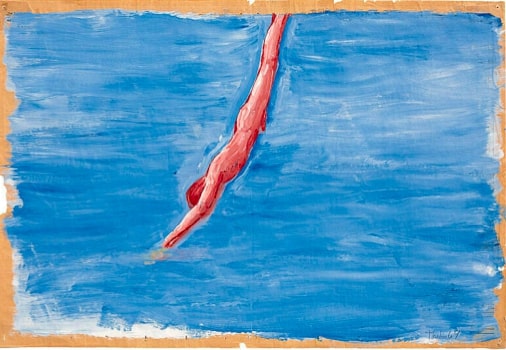
Paul
Thek, Untitled (Diver), 1969−70.
Synthetic polymer and gesso on newspaper, 22 1/4 × 33 3/16 in.
Little Untitled, where have I seen you before? Your hands are less clear by their dip in the painted sea. Paul’s last works layered blue acrylic gessoed paper rushing back it doesn’t let me rest with its calming shock of blue so interrupted, distortion of the diver’s cock directed towards the depths as all around him play the parts of lights on waters—“Our mother of puddled images fading away into deep blue polymer.” [28] He is always midway through the dive, so he’s not quite with me, but outside from where I crouch, almost unentirely a child.
*
2/27/23
“The function of art is revival.” – Paul Thek [29]
After a day of exploring Paul Thek’s works in various art books, I dream I am a diver who swims from ruin to ruin. Near the end of my dive, at the bottom of whatever body of water holds me, I swim upon the skull of a horse. The skull is enormous, larger than me, or else I am looking through the magnified lenses of glass, dream, and water. I peer through the hollows of the horse’s ears. Inside its skull is a mass of shadowy kelp, swaying tangled together in the place of thought. The secret rhythm of the kelp in the skull gives motion back to the otherwise too-still horse. Still like a portable relic in an importable ocean. How can I scavenge this? I remember thinking, wanting desperately, perhaps greedily, to carry the horse-skull up to the surface. I think this just before I wake, so close to the skull and the kelp inside, when revival for a moment is not the function, but the impulse.
Notes
[1] This is the name of a well-known folk song reworked by A.P. Carter of The Carter Family from a 1907 hymn written by Ada R. Haberson.
[2] Paul Thek & Susan Howe, Debths, New Directions, 19
[3] Henry Vaughan, Silex Scintillans, The Scholar Press Limited, 1968, 41
[4] Susan Howe, Debths, pg 29
[5] Paul Celan, Microliths: Posthumous Prose, translated by Pierre Joris, Contra Mundum Press, 2020
[6] Christine Smallwood, “The Mother-Daughter Thing”, The New York Times, 2015 The Mother-Daughter Thing (nytimes.com)
[7] Susan Howe, Concordance, New Directions, 28
[8] ibid, 15
[9] Susan Howe, Spontaneous Particulars: The Telepathy of the Archives, New Directions, 2020
[10] Susan Howe, Concordance, 24
[11] Robert Duncan, Bending the Bow, Jonathan Cape, 1971. iii-iv
[12] ibid, vii
[13] Nathaniel Mackey: “Uroboros: Dante and Seventeenth Century Suite”, Robert Duncan: Scales of the Marvelous, New Directions, 1979, 183
[14] ibid, 183
[15] Mackey, Robert Duncan: Scales of the Marvelous, 193
[16] Susan Howe, Debths, 108
[17] This is from Sally Oldfield’s song “Blue Water”
[18] Collection Carolyn Alexander, New York, Painting at the Edge of the World pg 345
[19] Susan Howe, Debths, 24
[20] This is true to my knowledge except in the case of Vaughan, who Howe doesn’t mention by name anywhere in Debths.
[21] Susan Howe, The Quarry, “The End of Art” (1974), New Directions, 219
[22] Susan Howe, Debths, 22
[23] Paul Thek / Processions, Institute of Contemporary Art, Falcon Press, Philadelphia, 60
[24] Richard Flood, Notes from the Playground, Paul Thek: Real Misunderstanding,2017, 21
[25] Paul Thek, The Tomb, 1967 | Whitney Museum of American Art
[26] Notes from the Playground, Richard Flood, Paul Thek: Real Misunderstanding, 2017, pg. 25
[27] Susan Howe, Debths, pg. 126
[28] ibid, 42
[29] Harald Szeeman, Selected Writings, Getty Research Institute, 2018, interview with Paul Thek


